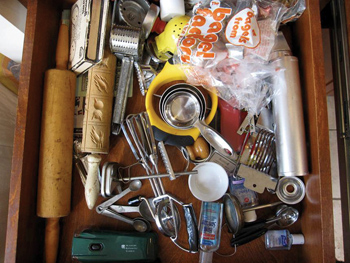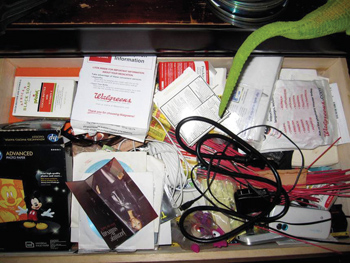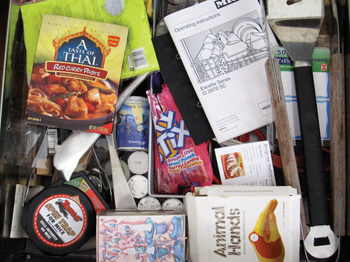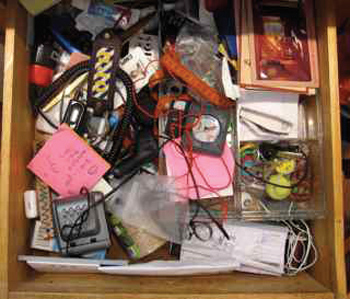By Rachel Achmad

Inda Schaenen ’82
[Messes] What do a firecracker, a machete and a package of Pixy Stix have in common, aside from being everything MacGyver needs to build a lawnmower? They are all items quietly residing in various household junk drawers, pulled open and celebrated in Inda Schaenen ’82’s latest project, Junk Drawers.
Schaenen and her husband, Michael Dee ’80, have raised their three children (including Pepper Dee ’15) in St. Louis, Mo., where Schaenen has worked as a journalist and book author. Now, by adding photography to the written word, she is curating her first mixed-media collection.
As Schaenen explains, the conception of Junk Drawers took place in her kitchen, as she sat considering her own family’s “important drawer” (or “hell hole,” if Michael’s talking). She says, “I got to wondering whether having a special place to keep important things all in a jumble was a universal human impulse.”
So she began to interview others about their own junk drawers and to collect their still-life photos and written descriptions of these spaces. Family members and friends were her early subjects, but she soon began to look further, soliciting images and notes through word of mouth, email and social media. Photos, some from Amherst alumni, have come from as far away as Israel, and more are promised from Europe and Australia. On her website, www.indaschaenen.com, she’s posted all of them.

The project holds appeal for viewers and contributors alike. “People are interested in other people’s embarrassing messes,” she says, while contributors seem to enjoy taking a meaningful look at their own drawers.

Schaenen’s son has a junk drawer in his bureau.
Beneath the junk, Schaenen’s writerly instinct discerns the outlines of stories. At first glance, every drawer is a tangle of items: thumbtacks, chewing gum, an unwound ball of string. But look longer and patterns emerge. Schaenen has found that each drawer typically has one of four themes: Synthesis (“fix-it” stuff, such as glue or nails), Analysis (deconstructive tools, like scissors), Documentation (ID cards, membership notifications) and Body Modifiers (prescriptions, lime-green nail polish).

And against the backdrop of these groupings, every drawer always contains “The One Idiosyncratic Thing” (TOIT), which is something that makes sense only to its own household: the orienteering compass in the Schaenen/Dee drawer, for example, or the firecracker sticks and bar of African soap in another.
She hopes that viewers will look at the photos and join her in trying to identify each TOIT and imagining what it reveals about the family outside the drawer. “Junk Drawers,” she believes, “celebrates the kind of manageable disorder that generates conversation.”

Her eventual goal is to have a collection of photos varied enough to substantiate her claim that junk drawers are a universal part of human nature. She hopes for future publication of the project as a magazine article or book. But for now, she continues to welcome contributions for display on the project’s website.

A friend’s drawer features temporary hand tattoos.
To get involved, take a photo of your exposed junk drawer and write up any thoughts or insights you have on its contents. Then, email the photo and text to indaschaenen@att.net, with “JUNK DRAWER” in the subject line.
Rachel Achmad writes for Recipe.com and is a frequent contributor to the Daily Hampshire Gazette in Northampton. She and her synthesis-themed junk drawer reside in Easthampton, Mass.